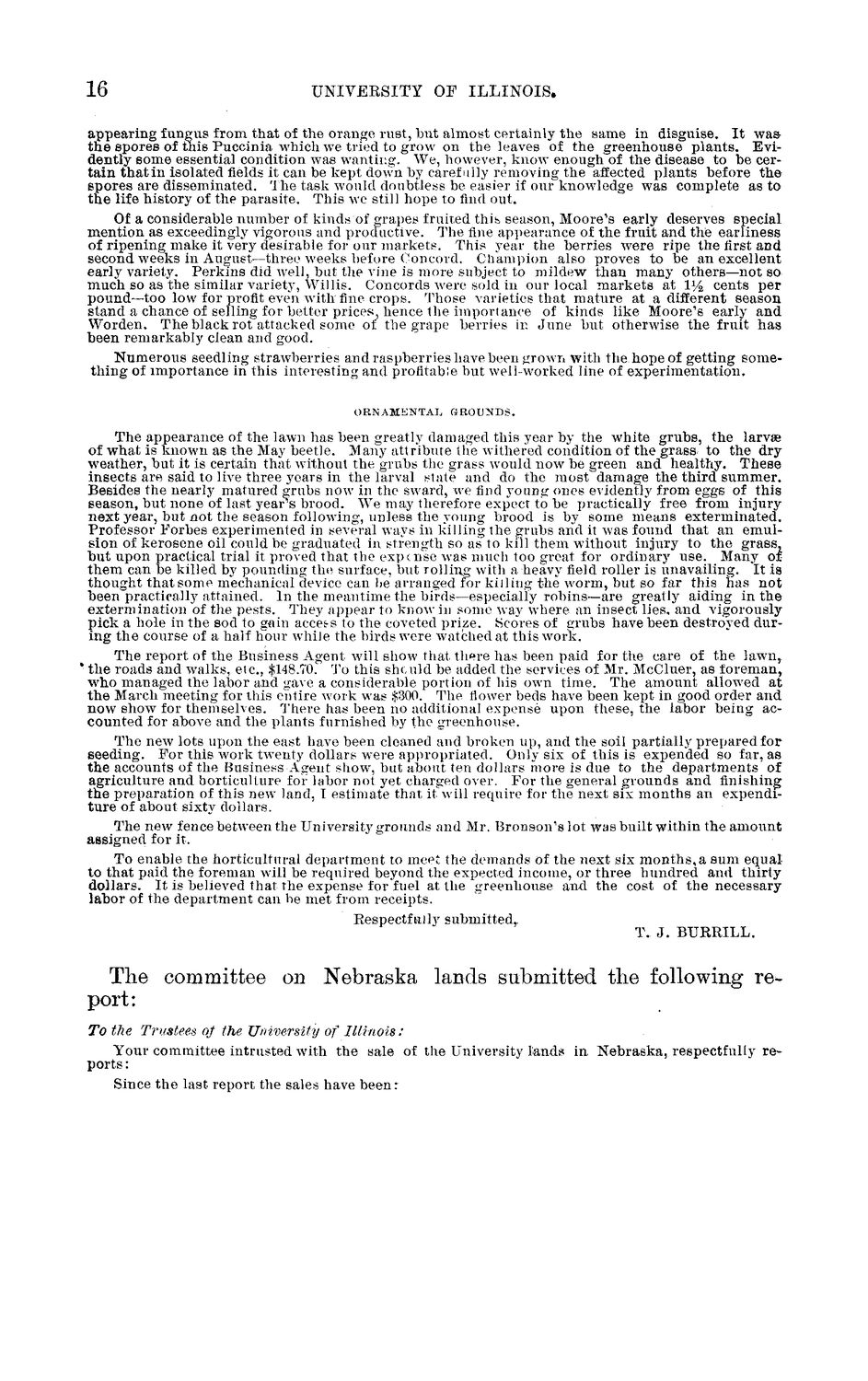| |
| |
Caption: Board of Trustees Minutes - 1888
This is a reduced-resolution page image for fast online browsing.

EXTRACTED TEXT FROM PAGE:
16 UNIVERSITY OF ILLINOIS. appearing fungus from that of the orange rust, but almost certainly the same in disguise. It was the spores of this Puccinia which we tried to grow on the leaves of the greenhouse plants. Evidently some essential condition was wanting. We, however, know enough of the disease to be certain that in isolated fields it can be kept down by carefully removing the affected plants before the spores are disseminated. The task would doubtless be easier if our knowledge was complete as to the life history of the parasite. This we still hope to find out. Of a considerable number of kinds of grapes fruited this season, Moored early deserves special mention as exceedingly vigorous and productive. The fine appearance of the fruit and the earliness of ripening make it very desirable for our markets. This year the berries were ripe the first and second weeks in August—three weeks before Concord. Champion also proves to be an excellent early variety. Perkins did well, but the vine is more subject to mildew than many others—not so much so as the similar variety, Willis. Concords were sold in our local markets at V/2 cents per pound—too low for profit even with fine crops. Those varieties that mature at a different season stand a chance of selling for better prices, hence the importance of kinds like Moore's early and Worden. The black rot attacked some of the grape berries in June but otherwise the fruit has been remarkably clean and good. Numerous seedling strawberries and raspberries have been grown with the hope of getting something of importance in this interesting and profitable but well-worked line of experimentation. ORNAMENTAL GROUNDS. The appearance of the lawn has been greatly damaged this year by the white grubs, the larvae of what is known as the May beetle. Many attribute the withered condition of the grass, to the dry weather, but it is certain that without the grubs the grass would now be green and healthy. These insects are said to live three years in the larval state and do the most damage the third summer. Besides the nearly matured grubs now in the sward, we find young ones evidently from eggs of this season, but none of last years brood. We may therefore expect to be practically free from injury next year, but not the season following, unless the young brood is by some means exterminated. Professor Forbes experimented in several ways in killing the grubs and it was found that an emulsion of kerosene oil could be graduated in strength so as to kill them without injury to the grass, but upon practical trial it proved that the expense was much too great for ordinary use. Many or them can be killed by pounding the surface, but rolling with a heavy field roller is unavailing. It is thought that some mechanical device can be arranged for killing the worm, but so far this has not been practically attained. In the meantime the birds—especially robins—are greatly aiding in the extermination of the pests. They appear to know in some way where an insect lies, and vigorously pick a hole in the sod to gain access to the coveted prize. Scores of grubs have been destroyed during the course of a half hour while the birds were watched at this work. The report of the Business Agent will show that there has been paid for the care of the lawn, * the roads and walks, etc., $148.70. To this should be added the services of Mr. McCluer, as foreman, who managed the labor and gave a considerable portion of his own time. The amount allowed at the March meeting for this entire work was $300. The flower beds have been kept in good order and now show for themselves. There has been no additional expense upon these, the labor being accounted for above and the plants furnished by the greenhouse. The new lots upon the east have been cleaned and broken up, and the soil partially prepared for seeding. For this work twenty dollars were appropriated. Only six of this is expended so far, as the accounts of the Business Agent show, but about ten dollars more is due to the departments of agriculture and horticulture for labor not yet charged over. For the general grounds and finishing the preparation of this new land, I estimate that it will require for the next six months an expenditure of about sixty dollars. The new fence between the University grounds and Mr. Bronson's lot was built within the amount assigned for it. To enable the horticultural department to meet the demands of the next six months, a sum equalto that paid the foreman will be required beyond the expected income, or three hundred and thirty dollars. It is believed that the expense for fuel at the greenhouse and the cost of the necessary labor of the department can be met from receipts. Eespectftilly submitted,. T. J . BURRILL. The committee on Nebraska lands submitted the following report: To the Trustees of the University of Illinois: Your committee intrusted with the sale of the University Hand!? in Nebraska, respectfully reports : Since the last report the sales have been:
| |